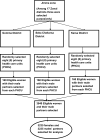Sex Disparities: Couple's Knowledge and Attitude Towards Obstetric Danger Signs and Maternal Health Care: in Rural Jimma Zone of Ethiopia
- PMID: 38831794
- PMCID: PMC11146344
- DOI: 10.2147/IJWH.S457357
Sex Disparities: Couple's Knowledge and Attitude Towards Obstetric Danger Signs and Maternal Health Care: in Rural Jimma Zone of Ethiopia
Abstract
Purpose: This study aimed to compare knowledge and attitudes towards obstetric danger signs and care between females receiving maternal care and their male partners.
Methods and materials: A community-based comparative cross-sectional study was conducted in the rural setting of Jimma, Ethiopia. Female and their male partners were selected randomly. The number of participants included from each sex was 3235 totaling 6470. Face-to-face data collection was employed using open data kit (ODK) software. A pre-test was performed before the data collection. Descriptive and analytical statistical analysis was used to compare knowledge and attitudes regarding obstetric danger signs and care. Predictor variables were declared considering a 95% confidence interval, adjusted odds ratio (AOR) and P-value less than 0.05.
Results: On average, male and female participants identified at least two obstetric danger signs. More females could mention more antenatal, childbirth, and postnatal danger signs than their male partners. Both females and their male partners who listened to the radio at least once per week had a statistically significant positive attitude towards obstetric care. Nonetheless, both had an almost similar magnitude of attitude towards obstetric care irrespective of belonging to different occupational, educational, and other social strata. Males' knowledge of danger signs during pregnancy (95% CI = (1.07-1.62), AOR = 1.32, P < 0.008) and postnatal care (95% CI = (1.16-1.89), AOR = 1.48, P < 0.002) had a statistically significant association with the females utilization antenatal care (ANC) service, though not delivery care (DC) or postnatal (PNC).
Conclusion: There were inequalities in obstetric danger signs knowledge between females and their male partners. Male partners' knowledge of obstetric danger signs is not only significant during pregnancy and delivery but also has a lasting impact on post-natal service utilization, which underscores the importance of their involvement in maternal healthcare.
Keywords: Ethiopia; attitude; knowledge; obstetric danger signs; sex.
© 2024 Shibeshi et al.
Conflict of interest statement
The authors report no conflicts of interest in this work.
Figures
References
-
- World Health Organization. Managing Maternal and Child Health Programmes: A Practical Guide. World Health Organization; 1997.
-
- World Health Organization. Improving Maternal and Newborn Health and Survival and Reducing Stillbirth: Progress Report 2023. World Health Organization; 2023.
-
- Doyal L. Gender Equity in Health*: debates and Dilemmas. In: Gender, Health and Healing. Routledge; 2012:183–197.
LinkOut - more resources
Full Text Sources



